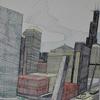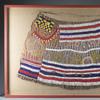Transformed Asian Art Museum Unveils New Pavilion with teamLab: Continuity
- June 12, 2021 18:26
“We believe that there is a borderless, continuous relationship between us and the world.” — Toshiyuki Inoko, teamLab founder
Swirls of butterflies that twirl and fade, sunflowers that bloom and perish, crisscrossing crows in flight, streams of luminous ink, rooms alive with light and feeling. Exclusively at the Asian Art Museum, teamLab: Continuity invites audiences to experience the immersive digital marvels of teamLab — an international art collective based in Tokyo whose exhibitions have achieved record-breaking global popularity. teamLab: Continuity is also the inaugural event in the brand-new Akiko Yamazaki and Jerry Yang Pavilion, the centerpiece of the museum’s five-year transformation project and San Francisco’s largest new art exhibition space. The exhibition will open to museum members for previews on July 16, 2021, and to the public on July 23, 2021 and will be on view through February 2022. (Advanced tickets for timed entry are required; on sale from June 22.)
Originally slated to open in May 2020, the Asian Art Museum postponed teamLab: Continuity due to the Covid-19 pandemic, which saw the museum close its on-site galleries to the public in March of that year. Now, with new health and safety guidelines in place and a worldwide vaccination campaign underway, the museum is thrilled to present this series of interactive digital installations spread across 8,500 square feet of newly constructed, never-before-experienced pavilion space.
Immersed in teeming wonderlands, visitors to the exhibition are encouraged to roam freely through digitally projected environments of vibrant color and sound that dissolve into one another. The 14 movement-sensitive artworks fill entire galleries and are hyper-responsive to human activity, transforming visitors into participants: rather than a series of preprogrammed movies, the digital animation is derived from dynamic algorithms that react to visitors’ locations and movements within the interconnecting gallery spaces. The result is an exhibition where the artworks are never exactly the same, and a journey that changes from moment to moment and visit to visit.
“The Asian Art Museum offers new worlds to explore and, with every visit, provides a place of creativity and connection,” says Dr. Jay Xu, Barbara Bass Bakar Director and CEO of the Asian Art Museum. “teamLab has been the inspiration for countless crowd-pleasing digital art experiences around the world, while remaining a leader in the field, innovating new ways to surprise and delight art-loving audiences. With its blend of jaw-dropping aesthetics and technological sophistication, teamLab: Continuity is the perfect way to reintroduce our transformed museum to a City and a community that is learning all over again the joy of coming together for shared moments of wonder — moments that ignite our imaginations while reflecting our own communal and ecological fragility and deep need for tenderness and hope.”
While there are currently several hundred programmers and designers who comprise the teamLab collective, as a practice they work together behind the scenes, collaboratively creating artworks that explore the relationship between the self and the world.
“Continuity prompts us to consider our own impact on the environment and relationship to technology as a force for social evolution,” says exhibition organizer Dr. Karin G. Oen, deputy director at NTU Centre for Contemporary Art Singapore and former associate curator of contemporary art at the Asian Art Museum. “It’s a subtle yet potent reminder that the art and experiences we most enjoy can also be revolutionary.”
Sound by Hideaki Takahashi (b. 1967). Interactive digital installation © teamLabIn 2015, the Asian Art Museum was the first museum in North America to collect an artwork from teamLab. teamLab: Continuity draws on traditional East Asian painting, calligraphy, and mythology — reflected in the museum’s own historical collections — to underscore teamLab’s commitment to the advancement of art that pushes boundaries, nurturing innovation and curiosity through technology.
In Tokyo, where the collective oversees a number of exhibition spaces, teamLab Borderless became the world’s most visited single-artist museum in the world in its inaugural year, welcoming 2.3 million visitors from 160 countries and regions.
With the opening of teamLab: Continuity comes the opportunity to take a closer look at Chanel Miller's I was, I am, I will be, the inaugural work in the Wilbur Gallery. Formerly on view only from the street during pandemic closures, Miller's incredible 75-foot mural inside the gallery beginning July 23. I was, I am, I will be, serving as an homage to experience rather than outcome, represents healing as a process with three distinct yet interchangeable parts: reflecting on the past, being mindful in the present, and envisioning the future.
Miller is a Palo Alto–born artist and writer based in San Francisco and New York. She first came into the public eye, anonymously, as “Emily Doe,” the victim of a 2015 Stanford University sexual assault whose powerful impact statement presented in court went viral. Miller relinquished her anonymity and reclaimed her identity in September 2019, when she published the critically acclaimed memoir, “Know My Name.” I was, I am, I will be is Miller’s first commissioned artwork for a museum.





















